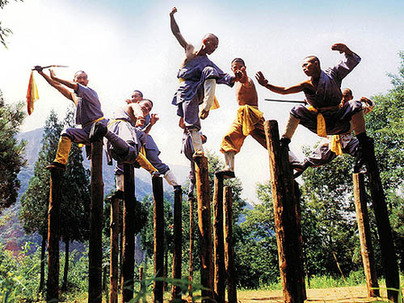Dengfeng
(about.com)
Updated: 2008-04-29 10:35
Updated: 2008-04-29 10:35
Dengfeng township in Henan Province is smaller than either Luoyang or Kaifeng, but it is well worth a visit if you have time. The township is located in the Songshan Mountains, about 45 miles from the provincial capital, Zhengzhou, and 50 miles east of Luoyang.
Songshan Mountain is famous as one of China's Five Sacred Mountains. The geography of the area is unusual and landscapes alone may be reason enough to visit Dengfeng. Songshan Scenic Area is one of the World Geoparks recognized by UNESCO. The Songshan mountain complex includes 36 peaks covering an area of about 20 square miles. The larger Geopark covers about 160 square miles. Taishi Mountain and Shaoshi Mountain and the primary peaks. The highest peak, Junji (or "The First Wife") Mountain is almost 5000 feet above sea level and provides a marvelous view of the Yellow River meandering across the countryside of China.

Dengfeng has a long history. A number of sites in and around the township are well worth the time involved in visiting them. Foremost on the list is the Shaolin Temple, the birthplace of both Kung Fu and Zen Buddhism. Other spots in the vicinity include:
The Songyue Temple, built in 520AD during the of the Northern Wei Dynasty, is about three miles northwest of Dengfeng. The temple, sitting at the foot of Taishi Mountain, boasts the oldest Buddhist pagoda in China. The pagoda is 12-sided; most such pagodas in China are octagonal, and no other pagodas found so far are 12 sided. Its 15 storeys reach to 148 feet. At ground level the pagoda is about 35 feet in diameter. The pagoda is made from a yellowish brick and held together with a clay mortar.
The Songyang Academy, less than two miles from Dengfeng township, was once one of the leading schools for training classical scholars in Imperial China. Built during the Northern Wei Dynasty (386-534 AD), graduates of the school served the emperor's government as civil service workers. The huge cypress trees in the academy's courtyard are regarded as the oldest in China, thought to be about 3,000 years old.
Gaocheng Observatory, about eight miles from Dengfeng, is the oldest facility of its kind in China. The observatory dates to the early portion of the Yuan Dynasty (1271-1368 AD). It was designed originally for use in predicting the time of the solstice each year. Astronomers at the site were able to calculate the actual length of the year to 365.2425 days some 300 years before Europeans managed to develope the Gregorian calendar.
Zhongyue Temple is also known as the Little Palace. It dates from the Qin Dynasty (221-206BC), making it one of the oldest temples still standing in China. During the Tang Dynasty (618-907AD) it was moved to its current location. The temple's assorted halls and pavilions, terraces and towers take up a total of almost four million square feet. Over 300 cypress trees, most twisted by the elements and age, occupy the courtyard.
Fawang Temple is another of the oldest Buddhist temples in China. It was constructed in 71 AD during the Han Dynasty, only three years after China's oldest Buddhist temple, White Horse Temple, in Luoyang. It has been renovated and added on to many times since. The temple grounds are also home to a square pagoda that stands about 33 feet high. Its roof is constructed in a Lamanistic style unusual in China. The pagoda dates to the Tang era.
Huishan Temple is about three miles north of Dengfeng at the foot of Huishan Temple lies at the south foot of Junji ("The First Wife") Mountain. It was evidently an imperial palace during the North Wei Dynasty and converted to use as a temple during the Sui Dynasty, in about 600 AD.
Yongtai Temple sits at the western base of Taishi Mountain, about seven miles northwest from Dengfeng. Built in 521AD during the Northern Wei Dynasty, it was destroyed completely during in 573AD but was rebuilt during the Sui Dynasty (589-618AD) and extensively renovated during the Ming and Qing eras.
The Nunnery of the First Ancestor of Chanzong occupies a spot at the foot of Wuru Mountain, just over a mile from Dengfeng. It was built in 1125AD to commemorate the Indian monk, Damo, who founded the Zen school of Buddhism.
Chongfu Temple is among the oldest Taoist temples still standing in China. It rests at the base of Taishi Mountain, just over a mile north of Dengfeng. Built in 110BC, most of the temple has been destroyed. But three halls still exist.
The Songshan Mountains area is also home to a huge number of steles by famous calligraphers.
At last report there was only one hotel for foreign visitors in Dengfeng. And the city is not on a rail line, so a three hour bus ride from Luoyand or Zhengzhou is the only way to get there. But the city gets about two million tourists a year and English-language signs are everywhere.
Dengfeng and the surrounding Songshan Scenic Area is among the more refreshing (and historic) places in China.
|
||
|
||
|
|
|
|